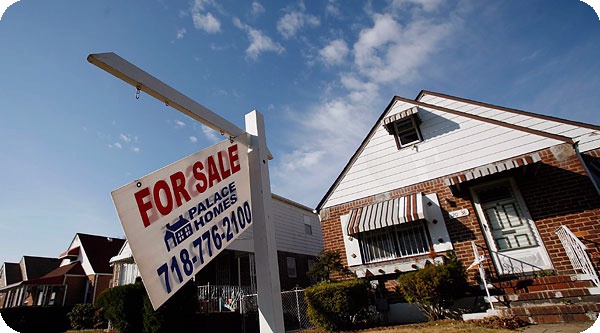|
|
|||||||||||||||||||||||||||||||
|
The Housing and Mortgage Industry of North AmericaPlaces to Live, Money to Build It
By Charles Moffat - October 2009. The housing and mortgage industries play huge roles in global economics. The construction industry, both for residential and commercial/industrial, makes up approx. 10% of the national GDP in the United States. This number fluctuates from year to year depending on the economy, but when the economy is strong you can expect the construction industry to be taking a larger piece of the pie. When people are working they save up money and eventually decide to make a down payment on a house. Or they already have a house they sell and decide to buy a new 'better' house. Either way they get a mortgage from a bank, purchase the house and presumably continue working and living happily. The constant sale of new houses fuels the construction / housing industry, makes jobs for both the construction workers, but also transportation of materials, brickmaking and mortar companies and the lumber & steel industries. Thus if the construction industry is booming, all their suppliers of raw materials will be booming too. And because those industries need tools, machinery and transportation this in turns fuels other industries like the cast & die industry, manufacturers and the truck/automotive industry. Then there is also feeding, clothing and entertaining all the workers of those combined industries, thus channeling money to other industries. Economics is largely about the speed at which money is spent and re-spent as it spreads through different companies & industries. It overall becomes cyclical because the creation of more jobs during the process allows more people to purchase houses of their own and thus fuel all the industries over again.
The lynchpin in all of this is: #1. Sustainable jobs, representing workers' ability to pay their mortgage payments. #2. Availability of credit from the banks to create those mortgages. In late 2007 the housing bubble burst. The strong economy that had been built up during the late 1990s had been squandered by George W. Bush, whose laissez-faire (don't touch) attitude towards economic policy caused the United States economy to falter under the pressure of two wars in the Middle East, skyrocketing oil prices and a president who was obsessed with foreign policy and ignored domestic policy. During Bush's 8 years in power the economy teetered back and forth between recession and growth until it finally collapsed in 2007. What happened was the build up in personal debt. Because the economy under Bush had been rocky even at the best of times many Americans were forced to rely on credit to make ends meet. This unfortunately later caught up to them in two ways: #1. Americans who would like to buy houses couldn't afford to make downpayments because their debt load was already too great. #2. Americans who already has mortgages couldn't afford to make their mortgage payments, thus defaulting on their bank loans.
Thus when the housing industry started seeing less new houses being built it meant a lot of construction workers were out of work or not getting enough work. They started to cutback on their purchases and other industries began to suffer. When this happen the whole economy faltered and began to slip into recession. But there was another factor as well. The Housing Bubble that had developed in recent years due to sub-prime mortgages. The banking industry, in an effort to be very competitive, had been giving new home owners very low interest rates for their mortgages. These low interest rates allowed new homebuyers to buy houses which normally would have been out of their price ranges because the mortgage payments would be lower. However because they were competing with other homebuyers, also with sub-prime mortgages, it meant that people were bidding on houses. The housing market became a sellers market, allowing prices of houses to skyrocket to amounts they weren't actually worth, but it didn't matter at the time because everyone was bidding and even old "fixer" type houses were selling for record prices. This bidding creates the Housing Bubble effect. Years later this over-bidding on houses caught up to both the homebuyers and the banks. When the economy soured under George W. Bush many Americans lost their jobs and couldn't afford to pay their mortgages, forfeiting their houses to the banks. Because people weren't looking to buy those houses the prices had to be dropped significantly to make a sale, thus creating huge losses for the banking industry. In some cases banks were also refusing to renew mortgages on houses which had been purchased during the Housing Bubble, because the house purchased for $400,000 five years earlier was only really worth about $200,000 in 2007 or 2008 after the housing bubble had burst. Homeowners had no choice to forfeit their mortgages, thus leaving the banks owning the property once more, which in turn created more losses for the banking industry because they had to sell the houses for much lower prices. Note: Savvy homebuyers could have re-purchased their old home at half the price they had originally purchased it for under the previous mortgage, but only if they could find a bank willing to give them credit. Defaulting on a mortgage hurts your credit rating quite a bit and the banks were losing so much money on mortgages in 2007 and 2008 they were becoming more cautious about lending money. By the summer of 2008 many American and international banks (including investment firms that had invested in the mortgage industry) were in such poor financial condition that bankruptcy was imminent for many of the companies. This collapse however would have meant a complete shutdown in the American economic cycle. If the banks shut down and couldn't offer mortgages to people, the housing industry would also shut down. Industries that supply materials and transportation would be cut off and this would spread to all other industries in the United States and even beyond its borders. The US economy makes up 28% of the global economy because of the speed at which Americans buy, sell and/or manufacture new products and services. If the banking industry collapsed the entire global economy would have shut down. So instead it was required that the US government, still under George W. Bush, step in and purchase large sections of the mortgage industry in order to keep the money flowing and the construction industry afloat. It was a necessary act to prevent complete disaster and to do so the United States would have to borrow money from overseas, mostly from China. This action was called a bailout by economists and politicians alike, but that term is inaccurate. The US government wasn't "giving" this money away. It was actually purchasing the banks and investment firms. The American government now owns most of the US banking industry via the US Federal Reserve which was in charge of purchasing all of mortgage debt.
As noted above other industries began to suffer under the recession, notably the American automotive industry. General Motors and Chrysler started asking for bailout money too, but eventually Barack Obama's new government agreed to do so, but like the banking industry before this money would not be a "free giveaway", instead the American government now owns large portions of both General Motors and Chrysler. Ford meanwhile has managed to avoid any bailout money and stay profitable. The automotive industry suffers from the same kind of ups and downs the housing industry sees, mostly due to how many Americans are working and saving money, but also the availability of credit for car loans. Thus we can measure the America's Economic Value by four things: #1. New housing, the number of applications for new housing startups. #2. Car sales, the number of automotives sold in the USA, not just American brands but foreign brands also. #3. The unemployment rate, the percentage of Americans currently living on unemployment insurance which peaked at a 26-year high of 9.7% in 2009. #4. Raw manufacturing numbers in terms of GDP. Obviously the numbers of the above 4 things will change frequently, but a quick Google News search will tell you what you want to know about the current economic status. Since the election of Barack Obama the American economy has seen slow but steady progress on these three fronts. Housing and car sales are going back up, and the unemployment rate is slowly going back down as more Americans find work and are able to buy houses/cars. Obama's stimulus package was aimed at getting Americans back to work, particularly in the construction industry by building/repairing roads, bridges, government buildings, schools, hospitals and anything else that had been waiting for government funding. All these extra things need both workers and materials. In an effort to keep the money in the USA he also promoted the idea that the majority of the materials should come from within the United States, thus fueling other US industries, but only if those companies could match international prices. With more Americans getting back to work it means the American economy has been kickstarted back into action and more Americans can go back to their normal economic routine of buying houses and cars.
The Canadian Housing / Mortgage Industry When the bubble burst in the USA it put a damper on the economy both in Canada and globally. While some countries might be more effected by this, Canada has been surprisingly resilient to the effects of the American Recession. Canada's industry has seen a slight downturn in manufacturing and car sales, but home sales are still steady. Canadian banks weren't giving out sub-prime mortgages and thus avoided the whole mortgage crisis entirely. In contrast to American banks and lending firms Canadian banks are notoriously stable and always posting profits. It is extremely rare for a Canadian bank to report a loss because they're much more cautious and self-regulated. As such its much easier to buy a house or get a mortgage in Canada. Canadians in general have less debt, better credit ratings and their economy is more robust because they have more manufacturing and mining/oil than the United States does in terms of GDP percentage wise. America's economy in comparison is 78.6% services and only 20.4% industry. Canada has 68.5% services and 29.2% industry. Thus as long as the world needs oil, steel, minerals and lumber the Canadian economy will stay strong and likewise Canada's housing/mortgage industry will stay robust.
|
|
||||||||||||||||||||||||||||||
|
Website Design + SEO by designSEO.ca ~ Owned + Edited by Suzanne MacNevin | |||||||||||||||||||||||||||||||




